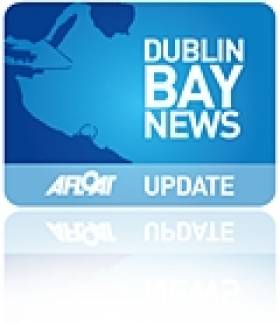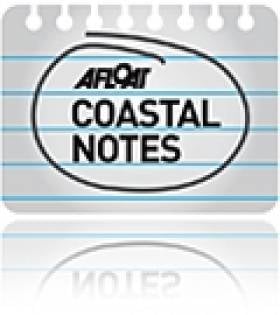Displaying items by tag: Killiney Beach
Dun Laoghaire-Rathdown County Council has closed two popular south Dublin beaches over elevated levels of bacteria in the water, as RTÉ News reports.
The temporary notice advising against swimming at Killiney Beach and White Rock Beach was issued yesterday (Saturday 5 June) and will remain in place until further testing of water samples gives the all-clear.
Elsewhere in Dublin, bathing is also currently prohibited at Balbriggan in the far north of the county and at Merrion Strand, which has been plagued by water quality issues in recent years although recent sampling has returned ‘Excellent’ results according to Beaches.ie
#coastal - Works to protect cliffs along Killiney Bay, in south Co. Dublin, from coastal erosion, have stepped up in recent weeks as sea born rock armour from neighbouring Co. Wicklow is been delivered onto the beach, writes Jehan Ashmore.
Integral to the works is the Irish flagged landing craft vessel, James, which Afloat reported last month following completion of refurbishment at the Kish Lighthouse for Irish Lights.
The work on Killiney Beach involves the craft operated by O'Malley Marine Plant, to shuttle loads of limestone varying between 3.5 to 5 tonnes apiece. The source for the armour is from the Roadstone Quarry with associated jetty located south of Arklow Port.
The Dun Laoghaire-Rathdown County Council coastal project at Seafield, Shankill, is the Corbawn Lane Beach Access and Coastal Project Improvement Works located at Shanganagh Cliffs, which historically is vulnerable to coastal erosion. The works involve a 180m stretch along the cliff.
According to DLRCC, the project cost as set out in the Council's 2018-2020 Capital Programme is €928,000 and allows for design, construction, project management and related costs.
Access from the cliff down to the beach was only made possible by pedestrians taking use of a series of public steps. Due to the works, DLRCC say it is not be possible to use this public access, and, depending on tide levels, it may not be possible to travel along the beach past the works.
As for direct access to the beach by road this is not possible, forcing the project to engage the services of James. The craft is ideal for such scenarios as the shallow draft vessel can approach the beach head-on and then lower its ro-ro landing ramp onto the shoreline. At this stage of the logistics, awaiting heavy machinery on the shore then drive on board to be loaded with limestone and transferred ashore.
Main contractors for the coastal works is MJS Civil Engineering based in Newtownmountkennedy. Co. Wicklow. The project arose following conclusions published in DLRCC's Coastal Defence Strategy Study 2010 and where a presentation was held in 2017 to outline recommendations.
Among the study's survey, three distinct areas along the Killiney Beach and neighbouring coastlines were identified. As for those at Seafield, findings concluded that this stretch south of Killiney beach, were deemed to have unacceptable risks, as the cliff at Shanganagh is eroding and is unstable.
Prior to the sea-born deliveries, stablising the cliff was carried out. According to MJS, a trench was dug at the foot of the cliffs formed of soft clay, this led to a concrete wing wall constructed to underpin the works. At this stage the rock-armour is now been placed firmly at the wall to secure and strenghten this part of the coastline.
Afloat confirmed with O'Malley Marine, that the works to haul the rock armour, from their side of the sea based operations is envisaged to be completed between 3-4 months.
In addition, MJS cited a minimum of 6,000 tons will be required at the foot of the cliffs, though potentially this estimate could increase to 10,000 tons. The engineering firm expected work to be completed in July.
Killiney's Blue Flag Lowered Again Over High E.Coli Readings
#DublinBay - Killiney Beach has had its Blue Flag lowered for the second time in four weeks after tests on Monday 11 August showed high levels of E.Coli and Enterococci in the water.
Dun Laoghaire-Rathdown County Council, which has also posted a no-swimming advisory at Sandycove Harbour for high levels of the latter contaminant, expects to learn the results of its latest water samples this Friday 15 August.
But for the meantime, Killiney's Blue Flag is removed pending the council's investigations into the cause of the high bacteria readings, which is not yet known.
Last month Killiney and White Rock in Dalkey were closed to swimming due to unsafe levels of bacteria in the coastal waters of south Dublin Bay.
It's the latest in a string of bad news for Dublin's beaches, following last week's bathing prohibition at 12 beaches in the north of the county, and the arrival of dangerous stinging sea creatures such as the Portuguese man o'war and the lions mane jellyfish.
Campaign to Stop Planned Oil Drill off Dalkey Island
#DALKEY ISLAND PROSPECT - An online petition organised by Protect Our Coast in protest over plans by Providence Resources to start exploratory drilling for oil and gas off Dalkey Island, in south Co. Dublin, has reached over 2,000 signatures to date, including support from overseas.
Providence Resources are seeking permission from the Department of Environment for a foreshore licence to carry out site investigation and drill testing in waters depths of 20-30m in the Kish Bank Basin, at the Dalkey Island 'Prospect'.
They propose drilling one exploratory well some 6kms offshore, though the exact location chosen for the well site is subject to results of seismic surveys. This particularly area lies closer to the coastline, as it is on the more westerly fringes of the exploratory block (33-21) zone.
The campaigners object to the proximity of the well site off Dalkey Island which is designated a Special Protection Area (SPA). The island is home to a resident herd of goats, is rich in birdlife, seals and cetaceans, notably bottlenose dolphins in neighbouring Killiney Bay, which have drawn recent media attention and aided the objectives of the campaign, see www.protectourcoast.net
In addition they oppose the drilling location given its closeness to a large urban population and the risk of an oil-spill and consequent effects to humans and the environment throughout Dublin Bay.
If granted, exploratory work is due to start this year, with Providence claiming the entire process would take up to six months, between survey and drilling operations. During part of that timeframe, up to two seismic vessels will be employed, prior to deploying a 'jack-up' rig to the well site.
Should the oil be commercially viable, the benefits of becoming self-sufficient and security of supply would be of significant economic benefit to Ireland. To date 100% of the country's oil and 95% of its gas is currently imported, and yet most of Ireland's natural resources are unexplored, according to Providence Resources.
Exploration is an expensive exercise and has no guarantee of discovery while the timeframe from discovery to production can typically take five to seven years.
"Yet," say Providence Resources, "the implications of discovering and utilising such a natural resource, and potentially becoming self-sufficient in energy terms, would be of significant economic benefit for Ireland Inc. in terms of taxation, employment, security of supply and skills development."
To read more information about Dalkey Island Prospect from Providence Resources, with maps, montages (including views from White Rock Beach) newsletters and video presentation visit www.providenceresources.com/dalkeyisland.aspx
As previously reported on Afloat.ie, the application for the foreshore license is currently on view in Dalkey and Dun Laoghaire Garda stations. The application contains maps, plans, and drawings which can be inspected, noting the public consultation process ends on Thursday 2nd February 2012.
In addition for information from the Department of Environment's website, click HERE. Those wishing to make an objection or representation of the sought license should make submissions to the Foreshore Unit of the department on close of business (also) on Thursday 2nd February 2012.
.
- Dalkey Island Prospect
- Dublin Bay News
- Providence Resources
- Protect Our Coast
- Dublin Bay Oil drilling
- Killiney Bay
- Dalkey Island
- Dalkey Island Goats
- Dalkey Dolphins
- Department of the Environment
- Foreshore License
- White Rock Beach
- Killiney Beach
- Kish Bank Basin
- Special Protection Area
- SPA
- JackUp rig
- seismic survey
- Irish economy
- Online petition
- Well Site
- Exploratory Well Kish Bank Basin
- Cetaceans
- bottlenose dolphins






























































